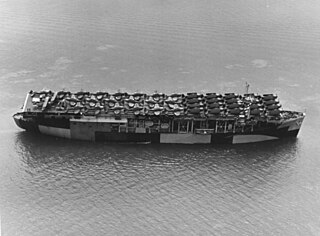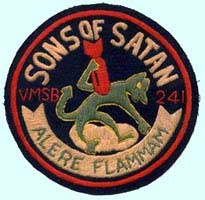
USS Wasp (CV-7) was a United States Navy aircraft carrier commissioned in 1940 and lost in action in 1942. She was the eighth ship named USS Wasp, and the sole ship of a class built to use up the remaining tonnage allowed to the U.S. for aircraft carriers under the treaties of the time. As a reduced-size version of the Yorktown-class aircraft carrier hull, Wasp was more vulnerable than other United States aircraft carriers available at the opening of hostilities. Wasp was initially employed in the Atlantic campaign, where Axis naval forces were perceived as less capable of inflicting decisive damage. After supporting the occupation of Iceland in 1941, Wasp joined the British Home Fleet in April 1942 and twice ferried British fighter aircraft to Malta.

USS Long Island (CVE-1) was lead ship of her class and the first escort carrier of the United States Navy. She was also the second ship to be named after Long Island, New York.

The Douglas TBD Devastator was an American torpedo bomber of the United States Navy. Ordered in 1934, it first flew in 1935 and entered service in 1937. At that point, it was the most advanced aircraft flying for the Navy, however by the time of the US entry into World War 2, the TBD was already obsolete.

The Douglas SBD Dauntless is a World War II American naval scout plane and dive bomber that was manufactured by Douglas Aircraft from 1940 through 1944. The SBD was the United States Navy's main carrier-based scout/dive bomber from mid-1940 through mid-1944. The SBD was also flown by the United States Marine Corps, both from land air bases and aircraft carriers. The SBD is best remembered as the bomber that delivered the fatal blows to the Japanese carriers at the Battle of Midway in June 1942. The type earned its nickname "Slow But Deadly" during this period, along with a rarely-used accompanying nickname of "Furious D."

The Grumman F4F Wildcat is an American carrier-based fighter aircraft that entered service in 1940 with the United States Navy, and the British Royal Navy where it was initially known as the Martlet. First used by the British in the North Atlantic, the Wildcat was the only effective fighter available to the United States Navy and Marine Corps in the Pacific Theater during the early part of the Second World War. The disappointing Brewster Buffalo was withdrawn in favor of the Wildcat and replaced as aircraft became available.

This is the order of battle for the Battle of Midway, a major engagement of the Pacific Theatre of World War II, fought 4–7 June 1942 by naval and air forces of Imperial Japan and the United States in the waters around Midway Atoll in the far northwestern Hawaiian Islands.

The Vought SB2U Vindicator is an American carrier-based dive bomber developed for the United States Navy in the 1930s, the first monoplane in this role. Vindicators still remained in service at the time of the Battle of Midway, but by 1943, all had been withdrawn to training units. It was known as the Chesapeake in Royal Navy service.

A folding wing is a wing configuration design feature of aircraft to save space and is typical of carrier-based aircraft that operate from the limited deck space of aircraft carriers. The folding allows the aircraft to occupy less space in a confined hangar because the folded wing normally rises over the fuselage decreasing the floor area of the aircraft. Vertical clearance is also limited in aircraft carrier hangar decks. In order to accommodate for this, some aircraft such as the Supermarine Seafire and Fairey Gannet have additional hinges to fold the wingtips downward, while others such as the A-5 Vigilante and S-3 Viking have folding tails. The F-14 Tomcat's variable-sweep wings could be "overswept" to occupy less space.

The National Naval Aviation Museum, formerly known as the National Museum of Naval Aviation and the Naval Aviation Museum, is a military and aerospace museum located at Naval Air Station Pensacola, Florida.

Patriots Point Naval & Maritime Museum is a naval museum located in Mount Pleasant, South Carolina, at the mouth of the Cooper River on the Charleston Harbor, across from Charleston.

Task Force is a 1949 American war film filmed in black-and-white with some Technicolor sequences about the development of U.S. aircraft carriers from USS Langley (CV-1) to USS Franklin (CV-13). Although Robert Montgomery was originally considered for the leading role, the film stars Gary Cooper, Jane Wyatt, Walter Brennan, Wayne Morris, Julie London and Jack Holt. Task Force was the only film Gary Cooper and Jane Wyatt made together, and was the last of the eight films Cooper and Walter Brennan made together. The U.S. Navy provided complete support in not only lending naval vessels and facilities, but also allowed the use of archival footage of the development of naval air power.

Marine Attack Squadron 231 (VMA-231) is a United States Marine Corps fixed wing attack squadron that consists of AV-8B Harrier (V/STOL) jets. The squadron, known as the "Ace of Spades", is based at Marine Corps Air Station Cherry Point, North Carolina and fall under the command of Marine Aircraft Group 14 (MAG-14) and the 2nd Marine Aircraft Wing.
The Air Zoo, founded as the Kalamazoo Aviation History Museum, is an aviation museum and indoor amusement park next to the Kalamazoo-Battle Creek International Airport in Portage, Michigan. The Air Zoo holds many historical and rare aircraft, including the world's fastest air-breathing aircraft, the SR-71B Blackbird. Many of its antique planes are airworthy. Among its other attractions are a 180-degree theater that projects a 2-D film simulation of a B-17 bombing mission during World War II; and various amusement rides, including flight simulators of a rocket trip to Mars, a U.S. Navy F/A-18 Hornet, a stunt biplane, a hot air balloon, a veteran U.S. Navy F-14A Tomcat that served aboard USS America, and more. Air Zoo is a Smithsonian Affiliate.

The USS Midway Museum is a historical naval aircraft carrier museum located in downtown San Diego, California at Navy Pier. The museum consists of the aircraft carrier Midway. The ship houses an extensive collection of aircraft, many of which were built in Southern California.

The Vought XSB3U was an American biplane scout bomber developed by Vought-Sikorsky for the United States Navy during the 1930s. Developed as an alternative to the SB2U Vindicator monoplane, the aircraft proved unsatisfactory to the Navy in comparison, and development was not pursued.
The Enterprise Air Group was established on 1 July 1938, encompassing all squadrons embarked in USS Enterprise (CV-6). The group was divided into four squadrons, each with eighteen aircraft dedicated to a particular role. The squadrons were designated according to their role, and all were given the unit number six, derived from the hull number of the Enterprise. Bombing Six (VB-6) was equipped with Douglas SBD-2 Dauntless dive bombers, Fighting Six (VF-6) with Grumman F4F-3 Wildcat fighters, and Torpedo Six (VT-6) with Douglas TBD Devastator torpedo bombers. The fourth squadron, Scouting Six (VS-6) also had the SBD-2 Dauntless, but was more focused on the scout bomber role. This air group was embarked on board the Enterprise at the time of the attack on Pearl Harbor.

Marine Attack Squadron 241 (VMA-241) was an aircraft squadron of the United States Marine Corps, known as the "Sons of Satan". The squadron was commissioned during World War II and took part in the Battle of Midway, sustaining 75% losses. It was extensively involved in combat while providing close air support during the 1944–1945 Philippines Campaign. The squadron, equipped with A-4 Skyhawk light attack aircraft, became part of the Marine Forces Reserve, based at Naval Air Station Los Alamitos, California, from 1946 until the 1960s.

















